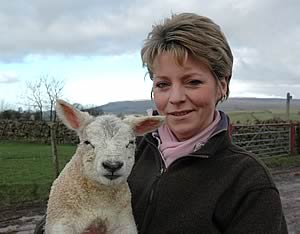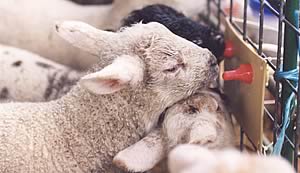 |
|||||||||
|
|||||||||||||||||||
|
|
Giving
Surplus Lambs a Chance Cumbrian farmers, Rachel Buckle and Sally Dixon will be among those who are offering every lamb the best possible opportunity to survive this coming season.
They are both fully aware of the future uncertainty of support payments under the new regime and realise they must focus on maximising potential output from their respective family’s sheep farming enterprises if they are to retain a viable businesses. That approach includes rearing every single surplus lamb. Rachel Buckle is among a growing number of pedigree breeders who have abandoned rearing surplus lambs with bottles and teats and switched to an ad-lib system, which has enabled her lambs to achieve equal performance and returns to those reared naturally. “We believe in giving every lamb a chance, however, bottle feeding 30 surplus lambs was taking up to four hours a day, and it was a job that always came last on the list of things to do. The lambs tended to suffer from digestive upsets, they developed pot bellies and were very readily identifiable as pet lambs,” she says. “Rearing surplus lambs professionally was an area we identified for improved income. In particular, since restocking, we have focused on breeding and rearing added value pedigree stock for the commercial marketplace,” said Rachel, who together with her husband Kevin runs flocks of pedigree Texel, Beltex and Swaledale, together with a commercial flock of Swaledale ewes to breed Mule gimmer lambs on their Buckles Farm, Barras, near Kirkby Stephen.
“Last year, after seeing one set up in Eden Farm Supplies, we introduced the Volac Ewe 2 system supplying warm ad-lib Lamlac ewe milk replacer and such were the results that it gave me real enthusiasm for rearing surplus lambs. “For starters, the feeder helped me to save up to three hours a day bottle feeding during one of our most labour intensive periods of the year. Also, when we integrated the Ewe 2 reared lambs shortly after weaning with those reared naturally there was no significant difference in weight between the two sets of lambs, nor was there any difference in their visual appearance” Rachel makes sure each surplus lamb drinks as much colostrum as possible from its dam within its first six hours of life, before being introduced to the Ewe 2. The 25 litre bucket feeder is designed to sit outside the pen, it comes with a 300W heater element that maintains milk at 30°C and which lambs access the milk via minisuckler teats fixed to the pen. The system requires 30 minutes at either end of the day washing out the bucket, replenishing the Lamlac, supplying clean water and solid feed. The surplus lambs are weaned abruptly at six weeks of age and continue to receive creep and fresh water when they join the naturally reared weaned lambs. At nearby Hartley Castle, Hartley, near Kirkby Stephen, Sally Dixon introduced a Volac Automatic Feeder last season to rear 127 surplus Texel cross Mule lambs to finishing and realised a gross margin of £13 per lamb. Apart from labour saving, she says the system also contributed towards improving whole farm efficiency. “The feeder enabled us to rear our surplus lambs to a high standard, it gave the remaining twins a much better chance on their respective dams and mastitis and other udder problems were minimised,” she said. Sally and her husband, David manage a 1,400 in lamb ewe flock comprising of a mix of pure Swaledales and Mules, and they are focused firmly on improving overall output. For example, better use of minerals and trace elements together with improved grassland management during last eight years are now enabling 85% of lambs for finishing to reach target weight off grass alone, while the Mule flock is now consistently achieving 200% lambs reared per ewe. “Last season 215 Mule ewes were scanned with triplets, simply far too many to be reared on a traditional cold milk ad-lib system. However, I had heard about the availability of an Automatic Feeder, on hire from Volac International and supplied with a full back up service from trained engineers.” she says. “The feeder immediately cut the time I was spending with surplus lambs from three to one hour per day cleaning the machine, checking the lambs were sucking, replenishing the system with Lamlac, topping up with fresh water and creep and bedding with clean straw. After that we checked the lambs three or four times a day, literally as we passed by the shed,” Sally explains. “Even introducing them to drink on the feeder after the first 24 hours on their dams was straightforward because they tended to mimic peer behaviour.” Weaning was abrupt at five weeks and we pushed them on with creep to try to minimize any checks and they reached 34kg target finishing weight from 12 weeks. The entire crop was finished by 16 weeks. “This system provided an all round solution and it also contributed to the enterprise’s profit. We’ll be introducing it again this year.”
| ||||||||||||||||||

|
|
||||||||||||||||||
| home | agri-services | pedigree
pen | news | dairy | beef | machinery property | organisations | site map |
|||||||||||||||||||

